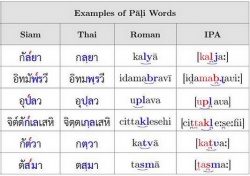Pāḷi
The word pāḷi simply means ‘a line of text’ but has come to be used as the name for the language that the Tipiṭaka used by Theravāda Buddhists is written in. Traditional Buddhists believe that the Buddha spoke Pāḷi although this is certainly not correct. Some modern philologists think Pāḷi was actually a language of western or central India, while others maintain that it was a literary language based on a form of Māgadhī. Whatever the case, it has long been considered a sacred language by Theravāda Buddhists, many of who believe that the Dhamma can only be fully understood by knowing Pāḷi. However, the Buddha knew that no one language is better than any other in transmitting truth and thus his exhortation: ‘I allow you to learn the Buddha’s words each in your own language.’ (Vin.II,139). Until recently, most books on Theravāda – histories, poems, commentaries, stories, etc – were written in Pāḷi. Any well-educated monk in Sri Lanka, Burma or Thailand will be proficient in Pāḷi.
A Handbook of Pali Literature, Oskar von Hinuber, 1996.
